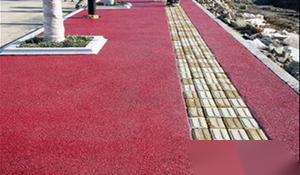Due to various factors arising from the rapid development of cities, urban ecology has been affected to some extent. Issues such as air pollution, groundwater resource scarcity, land subsidence, increased urban heat island effect, and urban noise pollution have all brought negative impacts to urban development.
Currently, the materials used in the construction of sidewalks are primarily cement sidewalk slabs or asphalt materials. These materials do not possess ecological or environmental protection functions and do not play a positive role in improving and alleviating urban environments. In recent years, economically developed countries in Europe and America, as well as neighboring Japan, have noticed this issue and have adopted permeable pavement roads as the main materials and technology in urban municipal construction. This is because the ecological and environmentally friendly permeable pavement can effectively address environmental pollution issues.
Permeable pavement's features
1.Ecological and Environmental Protection
The main materials of permeable pavement are gravel, cement, and hardening agents. Its main technical features include a rich void structure (15%~25% void ratio), which effectively allows rainwater to rapidly infiltrate underground, replenishing groundwater and providing a good solution to the severe scarcity of urban groundwater.
Due to the unique structure of permeable pavement, it significantly enhances the permeability and air permeability of the surface, keeps the surrounding soil moist, and can accumulate more heat, which is beneficial for regulating the temperature and humidity of urban surfaces and improving the ecological balance, thereby reducing the heat island effect. This is something traditional road paving materials such as marble, granite, asphalt, and concrete cannot achieve. Additionally, its unique void structure can effectively absorb noise generated by vehicles and pedestrians, creating a quiet and comfortable urban environment.
2.Function
Permeable pavement not only provides ecological and environmental benefits but also has safety features that can reduce the burden on urban drainage systems.
Permeable pavement can achieve a permeability rate of 32 to 52 liters/square meter/hour, which can easily alleviate drainage during regular rainfall. During concentrated rainfall, it can reduce the burden on urban drainage systems, allowing some rainwater to infiltrate underground instead of flowing into rivers through drainage systems, effectively preventing urban rivers from flooding and reducing pollution in public waterways.
The safety issues caused by water accumulation on urban roads, such as slippery surfaces, and the reflection problem caused by vehicle lights on standing water after rain can be effectively resolved. Additionally, due to the high permeability and wear resistance of permeable pavement, its safety performance is more thorough compared to traditional pavements.
3.Application
Since the materials used in permeable pavement are gravel, cement, and hardening agents, it possesses a higher load-bearing capacity, fully meeting national road strength requirements. Its durability far exceeds that of asphalt, approaching that of ordinary concrete, thereby avoiding the common disadvantages of short lifespan and economic inefficiency of traditional permeable bricks, while its strength can be increased according to the actual use of the road.
Especially during the rainy season, the advantages of permeable pavement become even more apparent, fully demonstrating its safety and usability in public areas.
According to the requirements for the installation of tactile paving on municipal roads, permeable pavement can be constructed simultaneously with road construction, using molds and auxiliary materials for stamping, thus fully maintaining the integrity of the entire road and avoiding future issues of uplift or subsidence, making it safer for visually impaired individuals.













